Recent Posts
Fire and Water Damage Mitigation
1/17/2025 (Permalink)
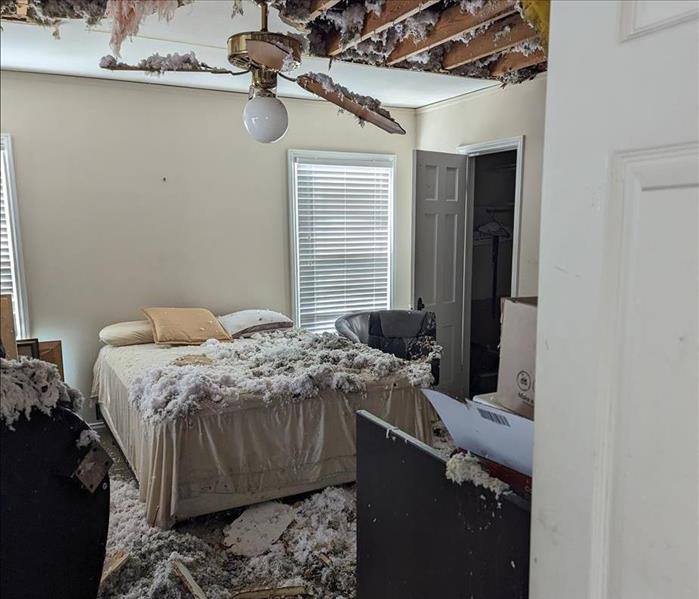 Bedroom after a fire.
Bedroom after a fire.
Water damage is an unfortunate byproduct when a fire occurs and needs to be treated as soon as possible. Sometimes the mitigation team has to wait for inspectors and/or adjusters to complete their investigation prior to beginning work, and it is important for the team to know how to deal with this red tape, as well as have a plan to move quickly once the all clear has been announced. There are a number of methods used to rid structures and contents of odor, as well as to dry them thoroughly so that mold or growth does not occur, and our team is trained to take the proper course of action quickly. Also, our managers can help navigate the confusing world or insurers and adjusters so that you can get back to normal ASAP.
Oak Cliff Business Water Damage
10/21/2024 (Permalink)
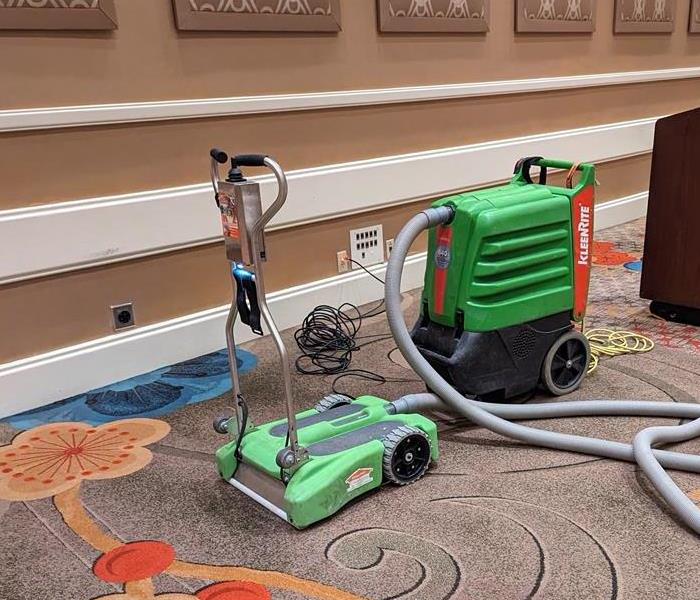 Extracting water damaged carpet.
Extracting water damaged carpet.
The Oak Cliff Community has a vibrant business landscape, and unfortunately sometimes business have burst pipes or water backups necessitating a call to SERVPRO. When a local business needed their carpeted ballroom extracted, our team was on the scene in short order. When done correctly and dried quickly, the carpet does not need replaced and can be salvaged.
Tips to Prepare for a Winter Storm
1/2/2024 (Permalink)
 Downtown Dallas covered in snow
Downtown Dallas covered in snow
Ice storms, with their glistening beauty and treacherous grip, can transform a winter wonderland into a hazardous landscape. But fear not, fellow adventurers! With a little preparation and knowledge, you can weather the icy blast and emerge victorious. So, grab your metaphorical snow shovel and let's dive into the essential tips for conquering an ice storm:Before the Freeze:
Heed the Forecast: Knowledge is power! Stay updated on weather alerts and forecasts. Knowing the timing and severity of the storm allows you to prioritize your preparations.
Stock Up on Supplies: Gather a well-stocked emergency kit for your home and car. Include essentials like non-perishable food, bottled water, a first-aid kit, flashlights, batteries, a battery-powered radio, and warm blankets. Don't forget pet supplies if you have furry companions!
Fortify Your Fortress: Winterize your home! Seal up leaks around doors and windows to prevent drafts and heat loss. Insulate exposed pipes to avoid freezing and potential bursts. We want to avoid calling a water damage restoration company if possible. Trim tree branches overhanging power lines to minimize the risk of outages.
Charge Up: Ensure your electronic devices are fully charged, and have spare batteries on hand. Consider investing in a portable power bank for extended outages.
Fuel Up: Fill your car's gas tank and check tire pressure. Keep an emergency kit in your car, including a shovel, tire chains, jumper cables, and road flares.
During the Storm:
- Hunker Down: The safest place during an ice storm is indoors. Avoid unnecessary travel, as roads become treacherous with even a thin layer of ice.
- Stay Informed: Monitor weather updates and advisories to stay aware of changing conditions.
- Power Play: If the power goes out, unplug appliances to prevent damage from power surges when electricity returns. Use candles or flashlights for lighting, and layer up with warm clothing and blankets to stay cozy.
- Communication Channels: Stick to battery-powered radios or phones for communication, as cell towers may be overloaded during the storm.
After the Storm:
- Tread Carefully: Once the storm passes, venturing outside requires caution. Be aware of downed power lines, falling tree branches, and hidden patches of black ice. Wear sturdy boots with good traction.
- Check on Neighbors: Look out for vulnerable neighbors who may need assistance, especially if they have lost power or have difficulty getting around.
- Document Damage: If your property sustains damage, take photos and document the situation for insurance purposes.
Bonus Tips:
- Learn how to operate alternative heating sources like fireplaces or wood stoves, in case you lose power.
- Have a plan for alternative cooking methods, such as camping stoves or grills.
- Fill bathtubs with water before the storm in case the water supply is interrupted.
- Keep a fire extinguisher readily available.
By following these tips and staying informed, you can approach ice storms with confidence and resilience. Remember, preparation is key! So, stock up, batten down the hatches, and enjoy a cup of hot cocoa as the icy symphony plays outside. With a little preparedness, you'll be singing victory carols when the thaw arrives.
Stay safe and warm out there!
Tips to Help Prepare Your Dallas Home for Winter
12/5/2023 (Permalink)
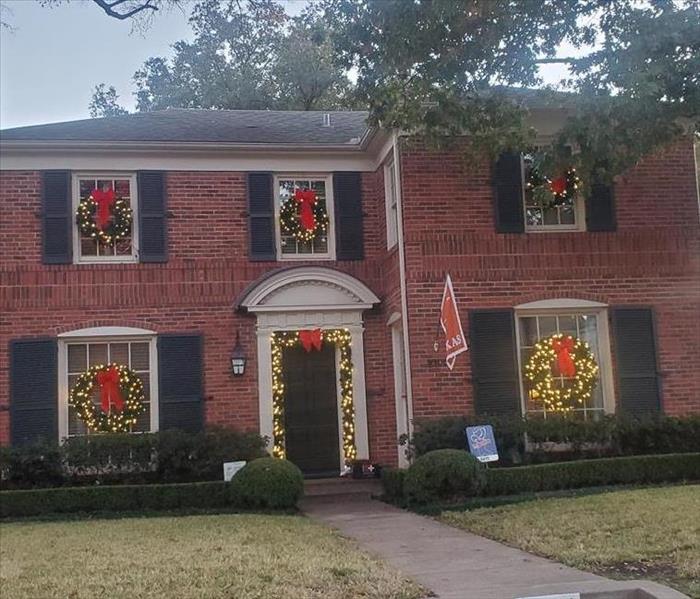 Dallas Home with Christmas Decorations
Dallas Home with Christmas Decorations
Winter is here, and it’s time to prepare your home for the cold weather. Dallas winters can be unpredictable, so it’s important to be ready for anything. Here are some tips to help you get started:
Find your water shutoff valve: In case of an emergency, it’s important to know where your water shutoff valve is and how to turn it off. According to AAA, the valve is usually located near your water heater tank if your home is built on a slab. If your home has a basement, it will likely be there, in the same places as your outdoor hose bib, just on the other side of the wall. If you have a crawl space, it will likely be there, usually along the front wall of the home. Worst case scenario, if you can’t find your shutoff, and your home is rapidly filling with water, you can turn it off from the main water line, usually located in the front of the house in a covered box 1. If you don't turn it off in time, make sure to find a professional water damage mitigation company.
Keep cold air out of the house: Repair or replace any problem spots on the exterior of your home that could allow for cold air to leak. This includes weather stripping around windows and doors, vents and fans, plumbing, air conditioners, and electrical gas lines. Also, use caulk or insulation to seal any holes, cracks, or small openings. You should also remove all hoses from exterior faucets, and clean gutters and trim any tree branches that could fall on your home 1.
Protect indoor pipes: The air inside your home’s walls, where pipes are located, can be colder than the interior rooms. AAA recommends setting the thermostat at a “reasonable temperature,” to keep the temperature regulated. Also, keep bathroom and kitchen cabinet doors open to allow warmer air to circulate pipes. If you think your pipes might freeze, let cold water drip from one faucet, which should be as far away from the water source as possible to allow water to flow the entire length of the system 1.
Supplies to have on-hand: It’s always a good idea to have supplies on-hand in case of an emergency. These include flashlights, batteries, blankets, bottled water, non-perishable food, and a first-aid kit. Make sure you have enough supplies to last at least three days 1
What are some Fall Home Safety Tips
10/23/2023 (Permalink)
 House with Halloween Decorations
House with Halloween Decorations
Fall is a beautiful season, but it can also be a dangerous one. With the leaves changing colors and the weather getting cooler, it’s important to take some precautions to keep your home safe. Here are some tips to help you stay safe this fall:
Check Your Smoke Detectors: Fall is a great time to check your smoke detectors and replace the batteries if necessary. Smoke detectors can save lives, so make sure they are working properly.
Clean Your Gutters: Falling leaves can clog your gutters and cause water damage to your home. Make sure to clean your gutters regularly to prevent this from happening.
Inspect Your Roof: Check your roof for any damage or leaks before the winter months arrive. Repairing any damage now can save you from costly repairs later.
Seal Windows and Doors: Seal any gaps around windows and doors to prevent cold air from entering your home. This will help keep your home warm and save you money on heating bills.
Check Your Heating System: Have your heating system inspected by a professional before the cold weather arrives. This will ensure that it is working properly and efficiently.
Prepare for Power Outages: Fall storms can cause power outages, so it’s important to be prepared. Have a backup generator or alternative heat source ready in case of an emergency.
Be Careful with Fireplaces: If you have a fireplace, make sure it is clean and free of debris before using it. Always use a screen to prevent sparks from flying out of the fireplace.
Be Prepared for Emergencies: Make sure you have an emergency kit ready in case of an emergency. This should include items such as flashlights, batteries, blankets, and non-perishable food.
Be Careful with Candles: Candles are a popular fall decoration, but they can also be dangerous if not used properly. Always keep candles away from flammable materials and never leave them unattended.
Be Careful with Space Heaters: Space heaters are a great way to stay warm during the fall months, but they can also be dangerous if not used properly. Keep them away from flammable materials and never leave them unattended, it is never fun to have to call a fire damage restoration company.
By following these tips, you can help keep your home safe this fall season!
What is Water Damage Mitigation vs Restoration
8/22/2023 (Permalink)
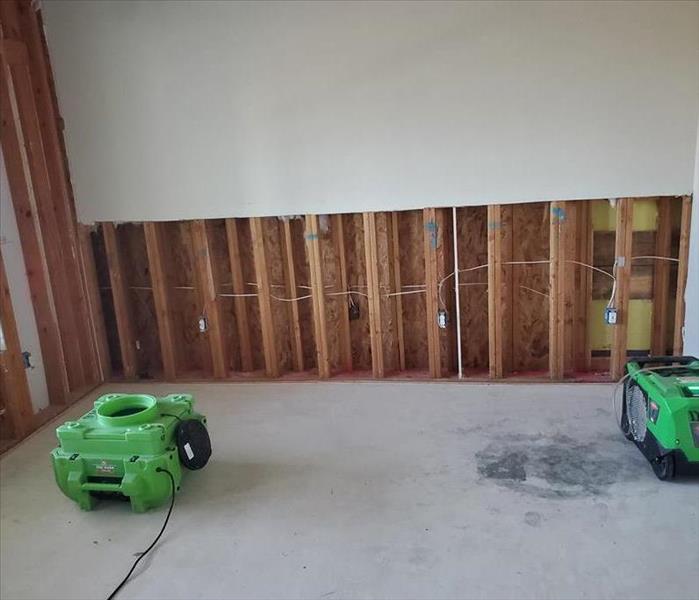 Room with floor and some drywall removed with drying equipment
Room with floor and some drywall removed with drying equipment
Water Damage Mitigation vs Restoration
When an event occurs that causes the need for water damage services, you will hear a variety of terms being used. Two of the most common terms that are often incorrectly used interchangeably are water damage mitigation and water damage restoration. These are actually 2 separate parts of the process.
Water Damage Mitigation
Water damage mitigation occurs soon after the initial water event. It prevents additional harm from water and protects the residential or commercial property structure along with the contents. It involves extracting water, drying, cleaning and disinfecting the affected areas.
Water Damage Restoration
Water damage restoration typically takes place after the mitigation has been completed. This step repairs and restores the water damage to the property and belongings. It concerns replacing damaged materials, eliminating mold, repairing roof damage. The goal here to get the property and contents back to preloss condition.
Need Water Damage Assistance?
Professional water damage mitigation and restoration companies are your best bet to have a successful completion of the process. Call the experts at SERVPRO of Dallas Central should you need help!
How Much Vinyl Plank Flooring to Remove Due to Water Damage
6/20/2023 (Permalink)
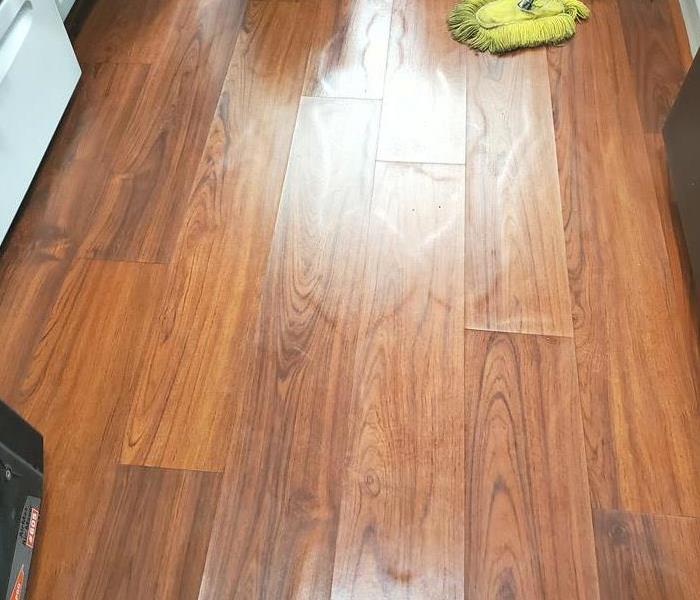 Vinyl plank flooring with visual water damage
Vinyl plank flooring with visual water damage
A home in the Five Mile Creek area of South Dallas had a sink leak that caused the need for water damage mitigation services. Water seeped into the vinyl plank floor in the kitchen, dining room and living room. This can cause visual damage through bubbling at the seams or down the plank. The visually damaged area of course needs to be removed but anything more than that?
Once a piece is pulled up, the underside can be reviewed to determine if water is still existent, and the neighboring piece needs to be removed as well. Planks should be continue to be removed until no more water is identified on the underside of the plank.
Often, flooring in the entire room or possibly the entire continuous flooring area will need to be removed. Flooring is constantly evolving and a style or color that is available today may not be available in a year. Replacing a portion of the floor means matching needs to occur and that is typically an issue.
In addition, the interlocking nature of vinyl plank flooring can make it challenging to just replace a portion.
Let us know if you need help removing a water damaged floor, call the experts at SERVPRO of Dallas Central!
Hotel Mattress Cleaning - Uncommon but Needed
5/5/2023 (Permalink)
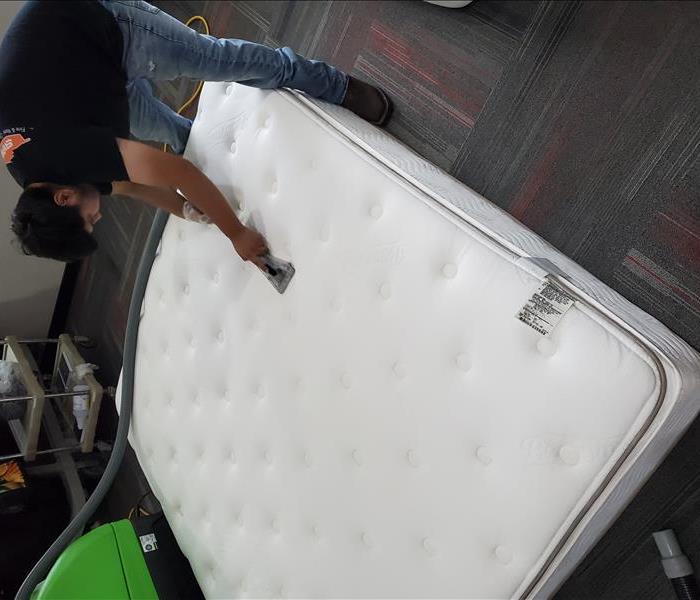 Hot water cleaning of hotel mattresses
Hot water cleaning of hotel mattresses
We received a special request from one of our hotel customers in the Arlington area. They had a number of mattresses they needed cleaned. These were not 10+ year old filthy mattresses that they were trying to get more usage out of. These are 1-2 year old mattresses that had a stain or two with some having stains not discerning to the naked eye. The city had done some inspections with a black light and determined that either they needed to be professionally cleaned or replaced.
Time was of the essence as the inspector was going to be back in 2 days to make sure the hotel had adhered to their directive. We were there the next morning with our hot water extraction cleaning machine and wand. Also in tow were our array of specialty cleaning solutions to attack the variety of unknown stains we may encounter.
After a thorough cleaning and a pre-check by a hotel manager and the owner, they were ready for the inspector. The next day we received great news, the mattresses passed with flying colors.
We have a very happy customer that is scheduling the next batch of mattresses for us to clean. Another successful job by SERVPRO of Dallas Central!
When Should I have my Air Ducts Cleaned?
5/3/2022 (Permalink)
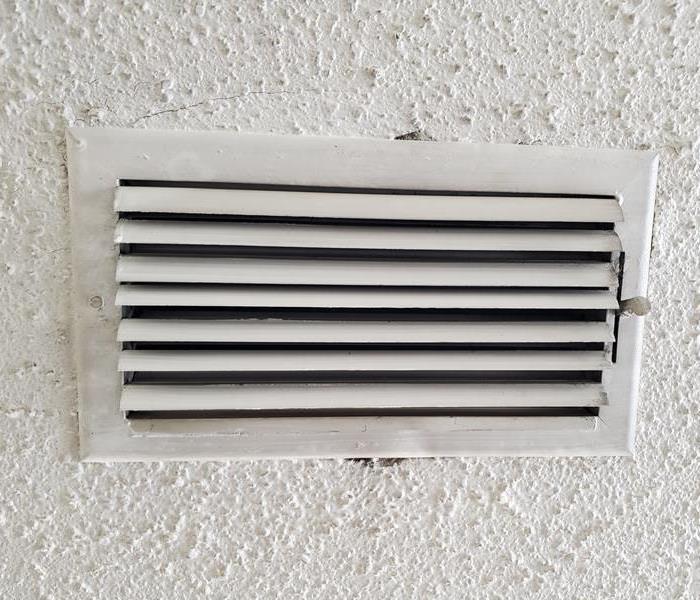 Residential Air Duct Vent on Ceiling
Residential Air Duct Vent on Ceiling
We often get called by residential customers about having their air ducts cleaned. The discussion usually involves the following questions: First, when should I get my air ducts cleaned? Second, how often should I get my air ducts cleaned?
The answer to these questions of course is “it depends”. What is the reason you are looking to have your air ducts cleaned? There are several reasons we typically hear: general maintenance, post-construction cleaning, a fire occurred, or we think there is mold.
General maintenance is the most frequent answer, and is goes something like, “This hasn’t ever been done since I lived here.” Or “This hasn’t been done in years.” Unless there is loose dirt and other soils actively coming out of your vents, most likely it does not need to be cleaned. Anything that is up there is adhering to the ducting and will continue to do so.
The next most common situation is doing this for post construction cleaning. In this case, there may be some loose dirt or drywall dust where it maybe advantageous to have them cleaned. However, when major construction is being done in a home, it is always a good idea to turn off the HVAC system and close vents if possible to prevent particulate from getting into the ducting. Ideally, you don’t have this issue to deal with when the project is complete.
When a fire occurs, the soot and smoke can be very pervasive and get everywhere. An air duct cleaning for moderate to light smoke might do the job of removing loose particles and odor. For heavy fires it is often recommended to replace the ducting altogether.
Mold is another situation when it can be a clean or replace situation. An HVAC repair company should first be called to determine what is causing mold in the system. Sometimes we have seen it as simple as all other vents are closed with only one vent open. Other items to consider, how much of the ducting is affected by mold or is it just one or two grills? Antimicrobial can be used to kill existing growth. The key is to figure out the cause so a conducive environment for mold does not exist going forward. It is often a good to place an air scrubber to help clean the air as a precaution.
In conclusion, more times than not it is not necessary to have your air ducts cleaned. As for how often, it is usually just under special situations or if you actively seen particles coming out of the ducting.
Can Flooring be Saved After Water Damage?
4/20/2022 (Permalink)
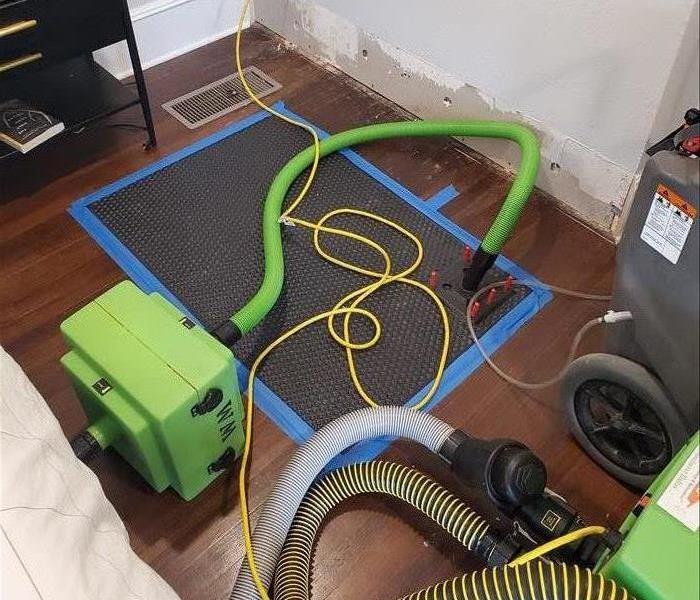 Specialty drying mat equipment drying down a hardwood floor
Specialty drying mat equipment drying down a hardwood floor
Unfortunately, water damage happens more often than we would like. 1 out of every 20 homeowners makes an insurance claim each year with around a fourth being from water damage/freezing. When a water damage event occurs, it can create a lot of havoc for the property owner.
On the front side of things, there are typically 3-5 days of drying out the structure. During this time, it will be determined what part of the structure is salvageable and what may just need to be removed to gain access to further wet areas and materials like insulation inside walls.
On the back side of things, there is the reconstruction of the structure. This may require packing out rooms or an entire house and moving offsite before construction can begin. This can take quite some time to schedule and complete. A lot of this decision rests upon flooring. Does the flooring need to be removed? If so, what type of flooring is it? Carpet, tile, laminate, hardwood, engineered hardwood? Each of these takes a different amount of time depending on the available material and process.
The type of flooring will determine if there is any hope of salvaging it. Often you will find tile in bathrooms, kitchens and laundry rooms…and for very good reason. Tile is usually salvageable. If tile is showing some give, or cracks have appeared since the event, the tile may need to be replaced. If not replaced, tile should be monitored over the next 12 months.
A general rule of thumb is laminate or engineered hardwood will usually need to come up. Engineered hardwoods look great these days but they are made out of layers of wood that can swell and degrade when wet. Glued down engineered hardwood can be the most challenging to remove and thus can increase the length of the process.
Carpet often can be saved but the carpet pad underneath needs to be replaced. The pad is like a sponge and retains moisture and odor. Fortunately, most carpet pad is pretty cheap and easy to replace. One of the tell tale signs that a carpet needs to be replaced is delamination. Delamination is when the backing to a carpet comes apart from the fibers.
Last but not least are hardwood floors. Different types of wood will be affected in different ways. Usually, if cupping or buckling is going to occur it will happen in 7-14 days. Sometimes the floor can settle back down, and sand and seal may be all that is needed. However, the key is bringing the moisture level back to par which is typically around 16. Every house and type of wood can have their own "standard". If wood cannot be brought back to the benchmark, it is usually recommended to replace the floor.
If you have a water damage event and have questions about your flooring, don't hesitate to give SERVPRO of Dallas Central a call at 214-664-9522!

 24/7 Emergency Service
24/7 Emergency Service









